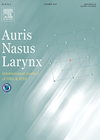
Journal Reviews
Obstructive sleep apnoea in common vestibular disorders
The importance of getting a good night’s sleep is often acknowledged but may be particularly difficult to achieve for those with obstructive sleep apnoea (OSA). In addition to high blood pressure, increased risk of stroke and depression, balance problems may...
The vitamin D deficiency and recurrent BPPV debate revisited
The role of calcium metabolism and disorders of bone mineral density in the evolution and recurrence of BPPV has been debated over the years. As a contribution to this debate, the authors undertook a prospective study into the correlation between...
Vestibular migraine or BPPV?
There are close similarities between benign paroxysmal positional vertigo (BPPV) and vestibular migraine (VM) as both can be presented by positional nystagmus. Though BPPV remains the commonest cause of pure positional vertigo, VM can mimic this condition. This study is...
Does the season affect the diagnosis of vestibular disorders?
There are mixed results in the literature regarding seasonal variation in the presentation of various peripheral vestibular disorders. In this large population study involving over 20,000 patients recruited from 116 ENT practices across Germany, the authors analysed the demographic characteristics...
Should all patients with BPPV have an MRI?
This paper describes an interesting series of 500 patients over a 10-year period with posterior canal BPPV, who had been investigated with MRI. The female to male ratio was 1.6:1 with a mean age of 56. There was a right...
Horizontal nystagmus: vestibular neuritis or lateral canal BPPV?
A horizontal nystagmus due to lateral canal (LSC) BPPV that is present in the upright position, that changes direction with head turn in the horizontal plane has been termed ‘pseudo-spontaneous nystagmus’ (PSN) because it mimics that of vestibular neuritis. The...











